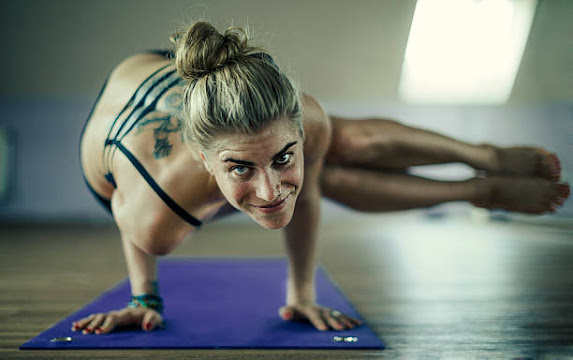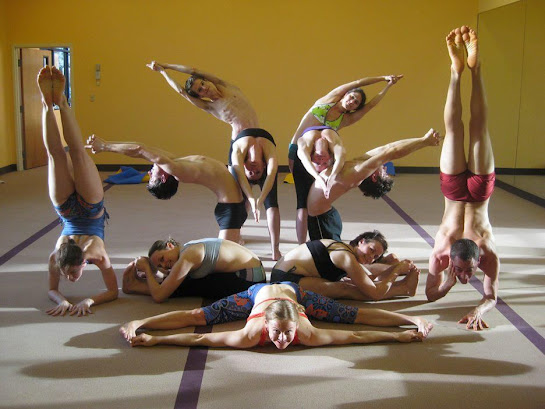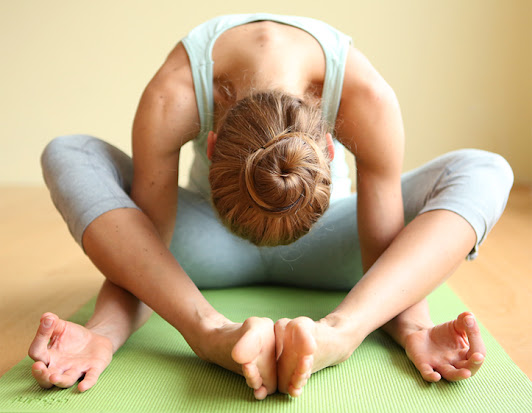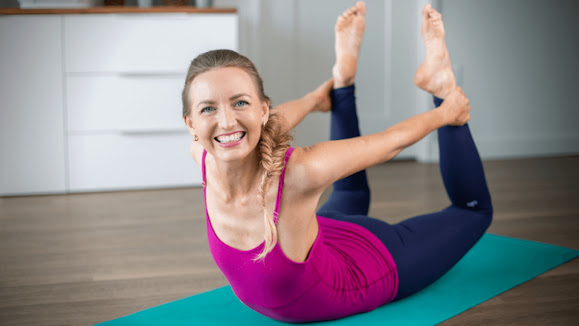Hot Yoga And Its Benefits
Note: Friends, if you want to read this article in any other language, please change the language from the translate button at the top of this article.
 |
| Hot yoga is a form of yoga practice performed in a heated room or studio |
Hot yoga is a form of yoga practice performed in a heated room or studio, typically ranging from 90 to 105 degrees Fahrenheit (32 to 40 degrees Celsius) with high humidity.
Hot Yoga was popularized in the 1970s by Bikram Choudhury, who developed the Bikram Yoga style, also known as "hot yoga."
Hot yoga classes typically follow a set sequence of postures, combining elements of traditional Hatha yoga with heat and humidity.
The elevated temperature and humidity levels are believed to increase flexibility, improve circulation, and promote detoxification through sweating.
Practicing yoga in a heated environment can enhance the cardiovascular system's work, increase blood flow to the muscles, and intensify the overall workout.
The heat is thought to relax the muscles and make them more pliable, enabling practitioners to deepen their stretches and achieve a greater range of motion.
It's important to note that hot yoga classes can vary in intensity, style, and temperature.
While some classes adhere strictly to the Bikram Yoga sequence, others may offer variations or incorporate different yoga styles.
It's advisable to check with the specific studio or instructor to understand their approach to hot yoga and any prerequisites or precautions you should take before attending a class.
Benefits Of Hot Yoga
Hot yoga is believed to offer several potential benefits, although it's important to note that individual experiences may vary.
Some potential benefits of hot yoga include:
1. Increased flexibility:
The elevated temperature in hot yoga classes can help loosen muscles, ligaments, and tendons, allowing for deeper stretches and improved flexibility over time.
2. Enhanced detoxification:
Sweating profusely during a hot yoga session is thought to aid in the release of toxins from the body, potentially promoting detoxification.
3. Improved cardiovascular health:
The combination of yoga postures and the heat can increase heart rate, improve circulation, and provide a cardiovascular workout.
This can potentially enhance cardiovascular health and stamina.
4. Stress reduction:
Like other forms of yoga, hot yoga emphasizes breath control, mindfulness, and relaxation.
The practice can help reduce stress levels, promote mental clarity, and provide a sense of overall well-being.
5. Muscle strengthening and toning:
Holding yoga poses in a heated environment can engage and challenge muscles, promoting strength, endurance, and toning.
6. Increased calorie burn:
The heat and intensity of hot yoga classes can lead to an increased calorie burn compared to regular yoga.
However, the exact number of calories burned will vary depending on factors such as the individual's weight, intensity of the practice, and duration of the session.
7. Improved mental focus:
Hot yoga requires concentration and mental focus to maintain proper form and alignment in challenging postures. Regular practice can help improve mental discipline and focus.
8. Joint mobility and pain relief:
The heat in hot yoga classes may help relieve joint stiffness and improve joint mobility. It can also provide temporary relief from muscle soreness and certain types of chronic pain.
It's important to approach hot yoga with caution, especially if you have any pre-existing medical conditions or are new to yoga.
Stay hydrated, listen to your body, and consult with a healthcare professional before starting a hot yoga practice, particularly if you have any concerns about heat intolerance or dehydration.
Methods Of Doing Hot Yoga
There are various methods or styles of hot yoga that you can explore.
Here are some of the popular ones:
1. Bikram Yoga:
 |
| Bikram Yoga is one of the most well-known styles of hot yoga |
Bikram Yoga is one of the most well-known styles of hot yoga.
It consists of a series of 26 postures and two breathing exercises performed in a room heated to 105 degrees Fahrenheit (40 degrees Celsius) with a humidity of 40%.
Each class follows the same sequence of postures, typically lasting 90 minutes.
2. Hot Vinyasa Flow:
 |
| This style combines flowing movements and sequences of Vinyasa yoga with the heat |
This style combines the flowing movements and sequences of Vinyasa yoga with the heat.
Classes may vary in terms of the specific sequence, but they typically involve continuous movement, synchronizing breath with movement.
The room is heated to a temperature ranging from 90 to 100 degrees Fahrenheit (32 to 38 degrees Celsius).
3. Power Yoga:
 |
| Power Yoga, also known as hot power yoga, is a dynamic and physically demanding style of yoga |
Power Yoga, also known as hot power yoga, is a dynamic and physically demanding style of yoga performed in a heated room.
It incorporates strength, flexibility, and cardiovascular elements into the practice. Power Yoga classes often have focus on building core strength and endurance.
4. Hot Yin Yoga:
 |
| Yin Yoga is a slower-paced, passive style of yoga |
Yin Yoga is a slower-paced, passive style of yoga that focuses on deep stretching and relaxation.
In hot Yin Yoga classes, the room is heated to a moderate temperature to help facilitate deeper stretching and release of tension in the connective tissues.
5. Hot Hatha Yoga:
 |
| Hatha yoga is a traditional form of yoga that focuses on physical postures |
Hatha yoga is a traditional form of yoga that focuses on physical postures (asanas) and breath control.
Hot Hatha Yoga classes incorporate the heat element to promote greater flexibility and relaxation.
6. Hot Pilates:
 |
| Hot Pilates combines the principles of Pilates with the heat of a hot yoga environment |
Hot Pilates combines the principles of Pilates with the heat of a hot yoga environment. It focuses on core strength, stability, and overall body conditioning.
The heat can enhance flexibility and increase the intensity of the workout.
It's worth noting that different studios and instructors may offer variations and combinations of these styles.
It's advisable to check with the specific studio or instructor to understand their approach and what to expect in their hot yoga classes.
Frequently Asked Questions On Hot Yoga
Here are some frequently asked questions on Hot Yoga
Q: Is hot yoga suitable for beginners?
A: Hot yoga can be practiced by beginners, but it's important to approach it with caution.
It's advisable to start with a beginner-friendly hot yoga class and inform the instructor about your level of experience.
Listen to your body, take breaks when needed, and stay hydrated during the practice.
Q: How hot is a typical hot yoga room?
A: A typical hot yoga room is heated to a temperature ranging from 90 to 105 degrees Fahrenheit (32 to 40 degrees Celsius).
The exact temperature may vary depending on the specific style and studio.
Q: What should I wear for hot yoga?
A: Wear lightweight, breathable clothing that allows for ease of movement and wicks away sweat.
Avoid heavy or restrictive clothing. Many people prefer to wear moisture-wicking fabrics and shorts or leggings.
Q: How long does a hot yoga class usually last?
A: Hot yoga classes typically last around 60 to 90 minutes, depending on the style and studio.
Some classes may be shorter or longer, so it's best to check the schedule or inquire with the studio.
Q: What are the benefits of practicing yoga in a heated room?
A: Practicing yoga in a heated room is believed to increase flexibility, improve circulation, promote detoxification through sweating, provide a cardiovascular workout, strengthen and tone muscles, reduce stress, and enhance mental focus.
However, individual experiences may vary.
Q: How often should I practice hot yoga?
A: The frequency of your hot yoga practice depends on your personal goals, fitness level, and schedule. Some people may choose to practice hot yoga a few times a week, while others may practice daily.
It's important to listen to your body and give yourself enough time to recover between sessions.
Q: Can I do hot yoga if I'm pregnant?
A: It's best to consult with your healthcare provider before practicing hot yoga during pregnancy.
The elevated heat and humidity levels in hot yoga classes may not be suitable for pregnant women.
Prenatal yoga classes specifically designed for pregnancy are often recommended instead.
Q: What precautions should I take in a hot yoga class?
A: To practice hot yoga safely, it's important to stay hydrated before, during, and after the class. Listen to your body and take breaks when needed.
If you have any medical conditions or concerns, consult with your healthcare provider before starting hot yoga.
It's also advisable to inform the instructor about any injuries or limitations you may have.
Q: Can I eat before a hot yoga class?
A: It's generally recommended to avoid heavy meals or eating a large meal close to the start of a hot yoga class.
However, it's important to have adequate energy, so having a light snack, such as a piece of fruit or a small portion of nuts, a couple of hours before the class can be beneficial.
Q: What should I bring to a hot yoga class?
A: It's recommended to bring a yoga mat, a large towel to cover the mat, a smaller towel for wiping sweat, a water bottle, and a change of clothes for after the class.
Some studios may provide rental mats or towels for a fee, so it's best to check with the specific studio beforehand.
Friends, Stay Fit, Stay Happy
--------------------------------------------------------
Friends, if you liked it, please share it with your friends.
SHARING IS CARING.
Compiled by: Paramjit Singh Rana

Comments
Post a Comment